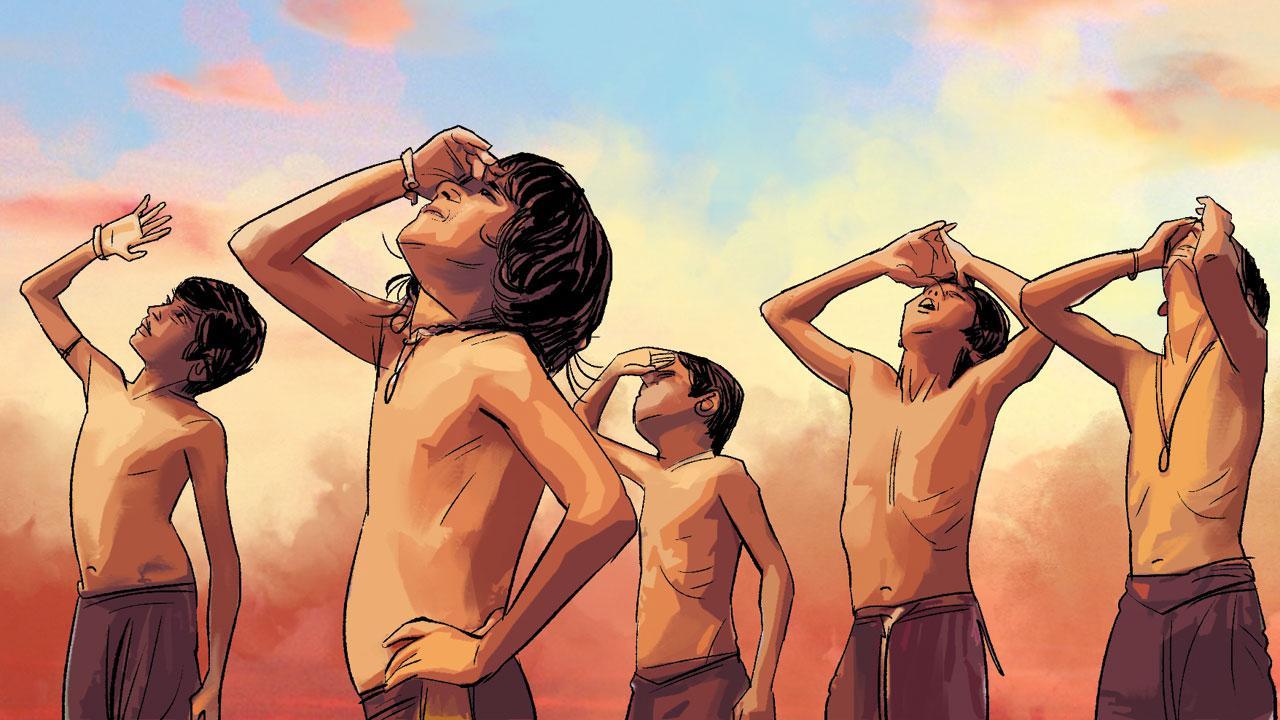Ironically, Chhello Show, shot in glorious 1:2.35 ratio or ‘Cinemascope’ (think Sholay), is a tribute to celluloid film that was shot digitally on an Arri Alexa

Illustration/Uday Mohite
![]() Pan Nalin’s Chhello Show (Last Film Show, an Indo-French collaboration in Gujarati), India’s entry for the Oscars, is a nostalgic love letter to cinema, as seen on nearly-vanished, 35-mm celluloid film, in single screen cinema theatres. It’s a coming of age drama that was at the Tribeca and BFI London Film Festivals. Perfectly timed, as exhibitors try to lure OTT-addicted audiences back to the theatres with the magic of the big screen, the film is now running in all-India cinemas. Tragically, there’s hardly any public cinema in India regularly showing 35-mm celluloid prints, apart from the National Film Archive of India theatre in Pune, or similar. Ironically, Chhello Show, shot in glorious 1:2.35 ratio or ‘Cinemascope’ (think Sholay), is a tribute to celluloid film that was shot digitally on an Arri Alexa.
Pan Nalin’s Chhello Show (Last Film Show, an Indo-French collaboration in Gujarati), India’s entry for the Oscars, is a nostalgic love letter to cinema, as seen on nearly-vanished, 35-mm celluloid film, in single screen cinema theatres. It’s a coming of age drama that was at the Tribeca and BFI London Film Festivals. Perfectly timed, as exhibitors try to lure OTT-addicted audiences back to the theatres with the magic of the big screen, the film is now running in all-India cinemas. Tragically, there’s hardly any public cinema in India regularly showing 35-mm celluloid prints, apart from the National Film Archive of India theatre in Pune, or similar. Ironically, Chhello Show, shot in glorious 1:2.35 ratio or ‘Cinemascope’ (think Sholay), is a tribute to celluloid film that was shot digitally on an Arri Alexa.
Samay (Bhavin Rabari), 9, growing up in Chalala, a small village in Gujarat, bunks school to watch movies at Galaxy cinema. He exchanges his dabba (Lunchbox, remember?) with the projectionist Fazal (Bhavesh Shrimali), who lets him watch films from the projection room. A Gujarati Cinema Paradiso that draws from Giuseppe Tornatore’s 1988 film, it extends the story of a kid and a film projectionist, with a reflection on the evolution of cinema itself.
Gujarati cinema prefers tawdry melodrama; a decade or two can pass between artistic Gujarati films: Ketan Mehta’s Bhavni Bhavai, 1981, Sanjiv Shah’s Hun Hunshi Hunshilal (Love in the Time of Malaria), 1992, Gyan Correa’s The Good Road, India’s Oscar entry, 2013, and Abhishek Shah’s Hellaro (National Film Award for Best Feature Film), 2019. Pan Nalin— originally Nalin Kumar Pandya from Adtala village, Gujarat, but long based in Paris—who has made films in Tibetan, Ladakhi, English and Hindi, finally makes a film in Gujarati.
Nalin has always had a sharp instinct for what makes India exotic for the Western gaze; his films include Khajuraho, Tulkus, Devadasi, Ayurveda: Art of Being, Samsara, Valley of Flowers and Faith Connections (he later made Angry Indian Goddesses); that gaze holds here too. This contrasts with the approach of, say, Shivendra Singh Dungarpur’s documentary Celluloid Man. In Chhello Show, writer-director Nalin directs with assurance a story that is partly autobiographical, if faltering a few times. The kitchen is set in the verandah to better shoot food recipes in bright tropical colours, never mind if a Gujarati dish is translated as spinach ravioli, and there are shots of Gir lions. “I want to study light, because light becomes stories, and stories become films,” is a profound line, but it sounds odd being spouted by a Gujarati village kid selling tea. There’s the conceit of the hero being called Samay (time); he’s the son of a chaiwallah; interesting, coming in the era of a Supreme Leader, also originally from the same state and profession, retro-glorifying the chaiwallah. But in fairness, Nalin, by including a Muslim projectionist, Fazal, quietly emphasises how our love of cinema is inclusive and secular.
The screenplay doesn’t create enough emotional investment in the Samay-Fazal relationship that will transform Samay’s life. Yet, it creates moments of wonder, and observes the harsh impact of advancing technology: a small digital box replaces Fazal, the enormous projection machine and reels. Nalin also addresses caste: high caste Samay’s dad allows him to see films only if they are religious, like Jai Mahakali. We willingly suspend disbelief during those marvellous moments when the kids do jugaad and create their own theatre in an abandoned building, projecting silent film bits and creating their own soundtrack. But it’s hard to do the same when Samay mentions greats like Guru Dutt and Kamal Amrohi.
Dilip Shankar takes risks, casting key protagonists Bhavin Rabari, a Rabari tribal, as Samay, and Bhavesh Shrimali as Fazal: the screenplay makes neither attractive nor lovable as such, yet their screen presence holds you. Richa Meena and Dipen Rawal are OK as Samay’s parents.
Cinematographer Swapnil Sonawane’s use of ‘Cinemascope’ immediately envelops us; he shoots in warm, glowing colours, with many wonderful moments, including a remarkable sequence as Samay watches the passing landscape from a train with new eyes. Editor Shreyas Beltangdy and Pavan Bhat keep us fairly engrossed. Music composer Cyril Morin and sound designers Gilles Benardeau and Harikumar M Nair are effective. The producers/backers include Roy Kapur Films, Orange Studio (France), Jugaad and Monsoon Films; Samuel Goldwyn Films is the US distributor. The women’s contribution includes CoProducers Virginie Lacombe and Malvika Khatri, costume designer Sia Seth and production designer consultant Namra Parikh. Recommended.
Meenakshi Shedde is India and South Asia Delegate to the Berlin International Film Festival, National Award-winning critic, curator to festivals worldwide and journalist.
Reach her at meenakshi.shedde@mid-day.com
 Subscribe today by clicking the link and stay updated with the latest news!" Click here!
Subscribe today by clicking the link and stay updated with the latest news!" Click here!










